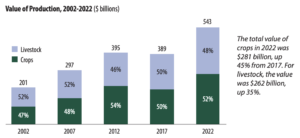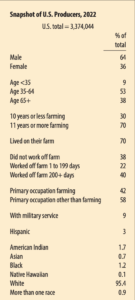The USDA is projecting that the ag trade deficit will shrink in FY2026 even more than previously anticipated. USDA expects the trade deficit to fall from $43.7 billion in FY2025…
Ag Census Finds Fewer Farms
The United States Department of Agriculture National Agricultural Statistics Service published data from the 2022 Census of Agriculture on Tuesday, a release that happens every 5 years. Among the most significant highlights was a decrease in the total number of farms in the U.S. from 2.04 million in 2017 to 1.90 million in 2022. Here are some other selected highlights:
Production
“In 2022, U.S. farms and ranches produced $543.1 billion in agricultural products, up from $388.5 billion in 2017,” the report said. “Crop and livestock commodities each accounted for approximately half of the total, with crops accounting for 52% of the value. In 2022, the value of crop sales exceeded livestock sales.”

“The largest farms (sales of $5 million or more) accounted for fewer than 1% of all farms but 42% of all sales,” the report said. “Farms with sales of $50,000 or less accounted for 74% of farms and 2% of sales.”
“As in 2017, California was the largest provider of agricultural products, with sales of $59 billion, 11% of the U.S. total,” the report said. “The top nine U.S. counties are in California, and the top county, Fresno, had larger agriculture sales than 23 individual states.”
The top 10 states for production in 2022 were, in order: California, Iowa, Texas, Nebraska, Minnesota, Illinois, Kansas, North Carolina, Indiana and Wisconsin.
“Cattle and calves was the top ranked commodity, with $89.4 billion in sales,” the report said. “Texas was the top state in cattle and calves sales, accounting for 17% of the U.S. total. The top five commodities accounted for $363 billion in sales, 67% of U.S. total agriculture sales.”
The top 5 commodities were, in order: cattle and calves, corn, poultry and eggs, soybeans, and milk.
Producers

“In 2022, 3.4 million producers operated 1.9 million farms covering 880.1 million acres that generated food, fuel and fiber for Americans and people around the world,” the report said. “The number of producers did not significantly change, while the number of farms decreased 6.9% (from 2.04 million to 1.90 million) since 2017 when the last ag census was conducted.”
“While the number of producers between the ages of 35-64 declined 9%, the number of producers 65 and over increased 12%, continuing the trend of an aging producer population,” the report said. “The number of young producers, those under 35, also increased slightly.”
Those increases mean the average age of U.S. producers is now “58.1 years, up 0.6 years from 2017.”
Female producers continued to account for 36% of the total number of U.S. producers, the same percentage as recorded in the 2017 Census.
“Male producers had higher rates of involvement in land use and/or crop, livestock, and marketing decisions than female producers,” the report said. “Female producers were most involved in day-to-day, record keeping and financial management decisions.”
For ethnicity and race, “3.2 million producers are white, 95% of the U.S. total,” the report said. The second largest group, Hispanic, accounts for 3% of the total.
Beginning producers
“Beginning farmers have 10 or fewer years of farming experience,” the report said. “New and beginning producers increased in both the number of producers and share of all producers. Slightly over 1 million of the 3.4 million producers in 2022 were beginning farmers. Their average age was 47.1, and their farms were smaller than average in both acres and sales.”
The top 10 states, by percent of beginning producers in the state, in 2022 were: Rhode Island (41.4%), Alaska (38.7%), Maine (35.9%), Colorado (35.6%), New Hampshire (35.3%), Hawaii (35.2%), Georgia (34.4%), Idaho (34.1%), Nevada (33.9%) and Florida (33.9%).





